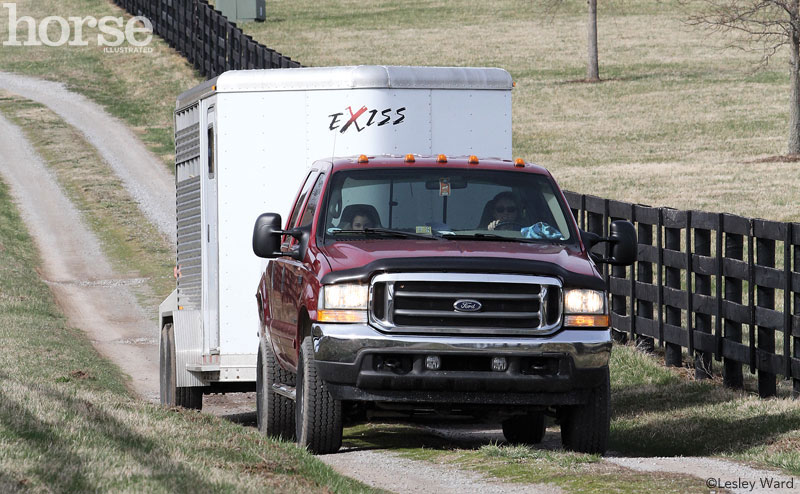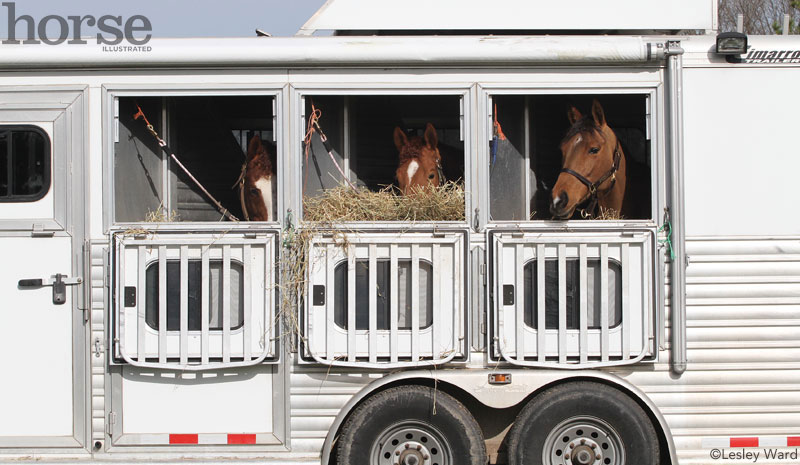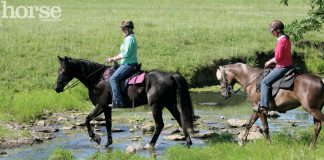One of the joys of owning a horse is the ability to explore new places, attend riding clinics, and show off your horse’s talent at events and competitions. All of these adventures usually require hauling a horse off the farm. Travel can be stressful to even the most seasoned competitor, but you can take steps to minimize the impact of transport. A trailer ride of more than four to six hours has the potential to affect several major body systems. However, managing the transit environment and your horse’s general health are key elements to delivering him to his destination in good condition so he can perform well.

Transport-Related Respiratory Problems
- Pre-existing respiratory disease
- The high-headed position from being tied in a trailer
- The number of horses within the trailer
- The air environment
If you load your horse on the trailer with a pre-existing respiratory condition, it will only get worse. The high-headed position when tied in a trailer compromises clearance of debris and microbes from the respiratory tract. Organisms normally present in the throat move down into the respiratory system, potentially causing pleurisy and pneumonia, often called “shipping fever.” The longer a horse’s head is tied up, the more bacteria and particles can accumulate in the airway, harming his immune response.
An important study revealed that restraining a horse’s head without giving him the ability to lower it elicits an exponential increase in microbes within six to 12 hours. Not only do microbes increase in the windpipe, but abnormal lung sounds (heard through a stethoscope) also develop.
Allowing a horse to lower his head for 30 minutes every six hours is not effective in entirely eliminating debris and microorganisms from the airways; it takes eight to 12 hours of untied rest for a horse’s respiratory system to clear.
In addition to each individual horse’s immune ability, the number of horses within a trailer also influences horse health. More horses means deteriorating air quality from increased heat and humidity in the trailer and increased circulation of microorganisms from accumulated manure, as well as increased dust related to hay consumption and churned up bedding. Soaking the hay helps to lessen dust and aerosolized debris. Be sure to hang hay bags high enough that a horse can’t entangle a leg or his face, and attach the hay bag so that it will break if necessary.
Preventive Strategies
The respiratory health variables are in your control to various extents: You can ensure that your horse is or hasn’t been sick prior to transport by closely monitoring him and having a health exam done by your veterinarian just before a journey. You can also control the number of horses in the trailer. Prior to leaving, ensure that they are all pronounced healthy to travel by your vet.
When you haul your horse in your own trailer, you have more latitude in how to manage the trip. If your horse loads and unloads well, it is best to periodically take your horse off the trailer while en route and allow him 15 to 20 minutes to lower his head to clear his airways a bit. Take care to unload only in safe areas where there is no traffic, obstacles or people. When possible, stop every four hours or so to let him graze, and clean manure and urine from the trailer before reloading him. Studies have shown that horses traveling with intermittent rest periods along with frequent trailer cleaning and disposal of manure and urine-soaked bedding had less harmful material in their airways upon arrival at their destination.
To help prevent shipping fever, keep your horse up to date on appropriate respiratory viral immunizations. Have his vaccines boosted (when due) at least two weeks in advance of travel to maximize immunity. A veterinary exam just prior to shipping can be instrumental in identifying subtle concerns that have the potential to develop into something more serious. Highly stressed horses may benefit from omeprazole treatment against gastric ulcers just before, during and immediately after a long journey.
Avoiding Overheating
Whenever possible, haul your horses in a trailer that has an insulated roof, as this keeps it cooler inside during hot weather. Open air vents and windows to improve air circulation within the trailer and to lessen heat and humidity buildup. Window screens allow manger windows to remain open in transit; if there are only bars and no screens, a fly mask protects your horse’s eyes from debris. If you don’t plan to unload your horse at rest stops, then at the very least, park in the shade and open all doors and windows to clear the heat and air. In warm weather, it helps to install a thermometer to give you an idea of the conditions your horse is experiencing. Then, you can make adjustments accordingly, such as frequency and length of rest stops or time of day to travel.
Travel in hot weather can be problematic if a horse is swathed in shipping boots, blankets or sheets, as covering the skin in any way has the potential to amplify heat stress in a trailer. Know how your horse might react in shipping boots, and weigh his temperament and how well he travels to the length of the trip, the presence of adjacent horses, and the risk of leaving his legs unprotected. Then you can decide if it is appropriate for him to wear shipping boots or not. When possible, place compatible horses next to each other in any travel situation—this is calming for each horse while also avoiding injuries related to bickering.
Some horses prefer facing backward if space allows, but not all do. It may take less muscular effort for a horse to travel facing a certain direction, lessening overall fatigue, overheating and travel stress. Regardless of the direction your horse is facing, tie him so he isn’t likely to try to turn around in a small space that could get him trapped.
Avoiding Dehydration
Balancing in the trailer requires considerable energy. Particularly in hot weather, horses will sweat, so dehydration is a very real concern. Offer water every three to four hours during a trip. The vehicle doesn’t need to be stopped for watering; you can hang a bucket that holds enough water for your horse to sip without sloshing it all over the floor. At rest stops, offer a fresh bucket of water and give your horse several opportunities to drink before assuming he won’t.
Horses need to drink while they’re in transit for more than three to four hours, and failure to do so may indicate impending shipping fever. At the very least, dehydration can increase the risk of developing health problems, including colic. Avoid anything that has the potential to interfere with a horse’s willingness to drink while traveling.
Some horses are bothered by electrolytes being syringed into their mouths, while others may willingly drink from an electrolyte-laced bucket of water or eat salt added to a mash. Short- to moderate-length journeys or reasonable heat and humidity conditions do not require electrolyte supplementation, particularly if a horse is eating hay along the way.
On short hauls up to eight hours, hay isn’t essential for replacing calories, but eating can help calm a nervous traveler, and the ability to nibble forage helps calm the stomachs of horses at risk of developing stress ulcers. On long hauls upwards of eight hours, horses will lose body weight, so they need to eat.

Horses enjoy hay and some fresh air during a break in their journey.
Stopping for 15 to 30 minutes every four to six hours to refuel or make human rest stops allows your horse’s muscles to relax and gives him a respite from the constant balancing act in the trailer. However, while these regular short rest breaks are beneficial, they don’t offer significant recovery time on long hauls. Whenever possible, don’t ask your horse to travel more than 8 to 12 hours without scheduling a rest period of six to eight hours, either as an overnight stay or an extended stop during the hottest daytime hours in summer. A longer rest period gives your horse a chance to relax, eat and rehydrate, and also helps to partially clear his respiratory tract.
Continual Monitoring
Once your horse has arrived at your destination, close observation of his demeanor, behavior and vital signs is critical in the first several days. Careful monitoring helps identify problems early on; this is especially true for horses hauled for 12 hours or more. Keep a log that documents the findings of your exam twice a day: appetite, water consumption, urine and manure output, attitude, and basic vital signs of rectal temperature, pulse, respiration, mucous membrane color and refill, and gut sounds. Twice-daily rectal temperature readings are very important.
Attention to the Details
On short trips of three to four hours, horses may not require any special precautions provided the driving and road conditions are reasonable, the trailer is well equipped to minimize heat and vibration, and the horse has no obvious temperament issues. Longer journeys require careful attention to avoid respiratory illness, overheating, fatigue and dehydration.
For both short and long journeys, it pays to do your homework in advance. Have your truck, trailer and hitch in tip-top mechanical shape, map out your route and rest stops, identify veterinary clinics along the way in case of trouble, bring as much familiar hay and water from home as possible, and know your horse’s quirks, anxieties and compatibility with accompanying horses. Have all travel paperwork (Coggins test, health certificate, equine passport and insurance papers) up to date and available for each horse.
As always, remember that each horse is an individual and should be considered and treated as such when trailering. Good judgment calls are as important in transport as they are in every other situation with horses. Safe travels!
Liked this article? Here are more trailering resources:
Horse Trailering Guide
NANCY S. LOVING, DVM, is a performance horse veterinarian based in Boulder, Colo., and is the author of All Horse Systems Go.
This article originally appeared in the October 2014 issue of Horse Illustrated magazine. Click here to subscribe!






Lots of good advise.
Great tips.